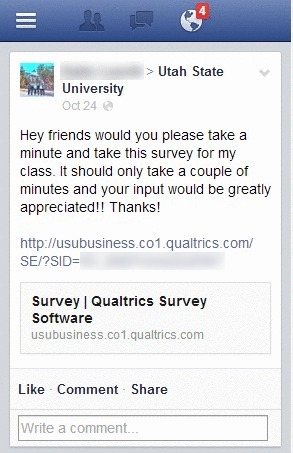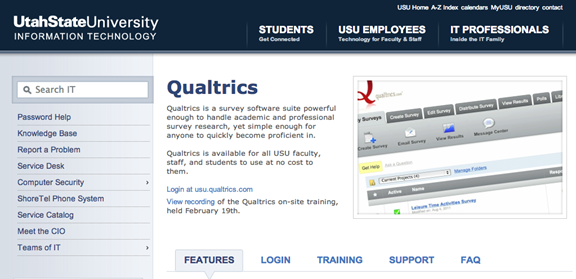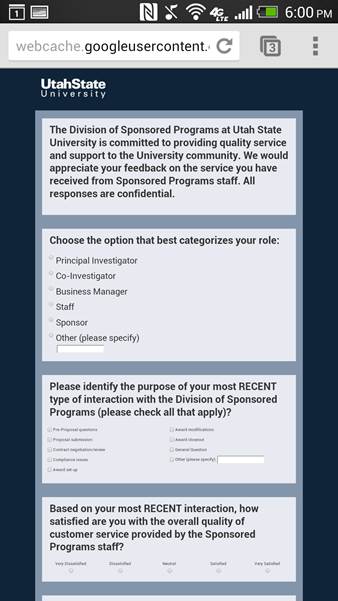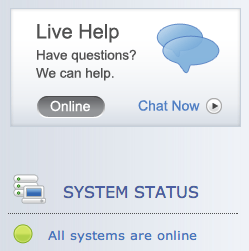Key Takeaways
- Utah State University invested in university-wide licensure of a research survey platform to enhance its collective knowledge base rather than supporting various software programs of varying capabilities in multiple departments.
- The research platform's familiarity among individuals and groups on campus helped ensure its successful adoption institution-wide, as well as its extension to uses beyond research, from interactive classrooms to alumni relations.
- A key benefit of licensing an enterprise solution was equalizing opportunities for faculty, staff, and students to conduct research at a professional level.
Without the right approach, the implementation of centralized technology can create more problems than it solves. It creates a dilemma for IT departments at large institutions where centralization is still debated: Do you sacrifice customization and usefulness to accommodate more users? Or, do you allow your budget to get nickel-and-dimed with dozens of piecemeal solutions and individual licenses?
At Utah State University, we recently invested in the university-wide licensure of an enterprise survey platform called Qualtrics Research Suite. This was no easy task. After watching the software gain popularity at the user level across campus, we piloted different use cases and funding scenarios to ensure that we weren't overestimating the demand or underestimating the unique needs that come out of all our departments and areas. (Figure 1 shows the landing page created by IT.) It takes work, but getting buy-in from users while still getting the numbers to make sense on the balance sheet was worth the effort. A win-win scenario is not out of reach.
Building a Foundation for Enterprise Research
Those who make purchasing decisions for their departments cannot be blamed for their protectiveness of resources. On the contrary, it's expected that USU faculty and staff will be responsible and efficient in the use of the funds they receive to complete their specific missions within budget. However, this territorial dynamic presents some challenges for those who have to provide centralized programs, facilities, or services. And in the IT area, where software is constantly evolving, we will never see a shortage of requests for updated tools, which creates fragmentation of technology. For example, some department heads might choose to absorb the cost of a premium service, but will avoid committing more of their own funds to the central budget so that everybody else can use it, fearing it might wind up costing them more (for a compromised outcome). Other areas may lack the budgetary freedom to buy software, so they go with inferior "freemium" solutions. When this happens, we cannot truly leverage our collective strength as a large institution.
At USU, we faced this "haves and have-nots" scenario with the various research platforms people were using around campus. The majority went with more economical (or free) survey tools, but these had extremely limited capabilities. Without a paid license, users had to split larger surveys into multiple parts, with inadequate capacity, analytics, and design. Other colleges or units chose to pay for premium research suites based on a match of demand, capability, and resources. This offered students and instructors within those areas a versatile and powerful academic instrument. Essentially, each group was getting what it paid for, but for an institution that strives to keep its students on equal footing across all departments, this particular inequality was disconcerting.
I should note that individual areas have the right to fund their own priorities. But in this digital age, we need our students — all of our students — to keep up to speed on the latest technology, be it a research platform, word-processing program, or online search engine. They all deserve to enter the workforce with universal technical skills.
A colleague of mine, Sterling Bone, who teaches marketing in our School of Business, thinks that a superior research platform gives faculty the ability to shorten the publication cycle and thus move more quickly toward tenure and advancement. He also takes great pride in sending his students out into the professional market with a deep familiarity with Qualtrics, which gives them a research edge. USU business students gained familiarity with the platform by conducting their own surveys for class assignments, often posting them to social media networks for wider access (see figure 1). But what if you happen to enroll in or hire on to a department that didn't pay for a professional-level platform? Are you stuck with an inferior resource? Will you have a less-competitive resume? This is what enterprise technology should prevent.

Figure 1. USU student-created class survey posted on Facebook
Looking for Campus-Wide Cost Savings
Even with what appeared to be plenty of conceptual momentum for buy-in, the funding model would make or break our enterprise endeavor. We used Excel spreadsheets to see how (or if) we could provide a system-wide research platform to all without shortchanging any single group. A university-wide mandate requiring every department to use and pay for a specific enterprise system might not prove cost-effective, after all, and why fight that battle otherwise?
First, we identified parties who were already using and paying for their research solution on an individual basis. Next, we calculated how much was spent collectively by those units. We measured that against the total number of areas that were willing to use and pay for a research platform, including those who had not previously owned an individual license.
The purely financial return on investment was obvious: as a whole, USU was spending almost what a site-wide license would cost, but getting access for just a few areas. In other words, as an institution, we were spending roughly 70 percent of the proposed site license while getting the benefits for less than 20 percent of our faculty and staff. By paying 30 percent more, we could open those benefits to 100 percent of faculty and staff as well as our 29,000 students.
The cost-effectiveness alone was compelling, but the huge increase in access and potential use was the larger story. For very little additional investment, we would see a significant impact on USU's collective knowledge base through higher-quality surveys, research, and analysis, and could deploy new methods for communication and collaboration. We worked to ensure funding commitments, taking great care to keep the funding model fair and equitable for everybody. Technically, this model would have people paying for the platform who don't actually use it — just as there are people paying for the water fountains who don't use them — but it would put a powerful resource within reach of everybody who wants it without exhausting our servers or draining our budgets.
In the course of those discussions, however, it was decided that the license would be wholly funded in its first year by Mark McClellan, USU's vice president for research and graduate studies, with the expectation that we would shift to a distributed funding model soon. In January of this year, we went all in on our license.
Training the Users
One of the reasons for setting our sights on university-wide adoption of the Qualtrics platform was that it had already gained traction organically among various areas and individuals. Beyond popularity, however, an enterprise solution would only be feasible if it was cloud-based and globally accessible (see figure 2). We needed a strong mobile presence (see figure 3) for the tech-savvy as well as a user-friendly desktop interface for those who prefer their PCs. We also created a live help desk feature to offer technical support to our users (see figure 4).

Figure 2. USU IT–created Qualtrics landing page, where students, faculty, and staff can log in, watch training videos, troubleshoot, and chat with live support staff

Figure 3. USU IT needed a platform that could adapt to any device with mobile-responsive themes

Figure 4. Live support via chat to help the campus community troubleshoot their data collection projects
In IT, we were charged with developing a training and information site for the new platform. We encountered challenges in getting everyone from professors to administrators to leverage the service's capabilities. The institution has only scratched the surface regarding use levels, as many potential users need a more illustrative approach to grasp the possibilities.
IT also owns and manages the technical and contractual processes, including integrating single sign-on authentication so that everybody at the institution can easily avail themselves of the research platform. The central IT department will need to ensure that university single-sign-on credentials are integrated and operational after the institution obtains a campus-wide license. In addition, users of the system will still have to migrate their existing content where desired to the platform.
We also enlisted the services of university marketing staff to help create and distribute marketing materials for training events and other promotions. And we continue to push out periodic event reminders and newsletters. People have responded just as we predicted: When a training program for the platform was offered at this year's Research Week, the seating was completely booked within hours and the program was standing-room only.
USU training video for Qualtrics (42:54 minutes)
Of course, achieving the kind of adoption that we anticipated requires that we keep aggressively planning for the near future. We need to make using the research suite as simple and straightforward as possible for new users.
Creating New Uses in Different Departments
We now have 533 users on our site license, with 1,074 surveys created and 29,048 responses collected just since the January centralization. USU runs reports to assess the usage of the Qualtrics platform — an essential element of implementing a distributed funding model (see figure 5).

Figure 5. Report showing usage of the Qualtrics platform
Perhaps the most exciting part is the creative use cases beyond academic research that we have seen across many campus groups and departments.
- Interactive Classrooms: Sterling Bone used surveys to get feedback from students about what they were up to in class, including in-class competitions. His midterm evaluations, which previously required paper and time (with a turnaround that was too slow for him to make in-course adjustments) were all done in real time.
- Data Collection: Lee Bartelme, our webmaster for regional campuses and distance education, started using Qualtrics for all his forms and data-collection mechanisms, as well as scholarship and waiver applications, material order forms, surveys, and online orientation sessions.
- Instructor Portal: Bartelme's shop also implemented a new instructor portal, which now allows instructors to order their course materials through the cloud rather than e-mail. He also moved the series of videos and readings from their online orientation program over to the platform, which is able to gather data from the orientation and feed it into the customer relationship management tool they were already using.
- Alumni Relations: In the case of Brandon Taylor, director of marketing and communications for the Office of Advancement and Alumni Relations, it is imperative that in all communications with our alumni, every interaction is positive and the USU brand is front and center. The technology allows all outgoing communications to be feature rich but also simple enough for the alumni who receive the surveys to complete them easily and the staff who design them to do so efficiently.
- Job Searches: During a search to fill an open position, the survey platform was used to get a ranking of the candidate pool prior to the first meeting so that the first discussions of the search committee could be more efficient. It was a hit with the committee, and it enabled its members to devote more time to consideration of the applicants, rather than logistics, during the hiring process.
The creative use cases are contagious — every time somebody uses the platform in a unique way, others get a broader picture of its potential.
In the IT world you're either adapting or you're falling behind — the march of technology isn't going to slow down and wait for us to catch up. But when we have the opportunity to consider other enterprise solutions down the road, our current experience will provide the blueprint for a distributed funding model (and the credibility to gather support for it). We won't always find a solution that lines up so precisely with our needs, but it is encouraging to know that "enterprise" doesn't necessarily mean "unwelcome compromise" to our campus community.
© 2013 Eric Hawley. The text of this EDUCAUSE Review Online article is licensed under the Creative Commons Attribution 3.0 license.
